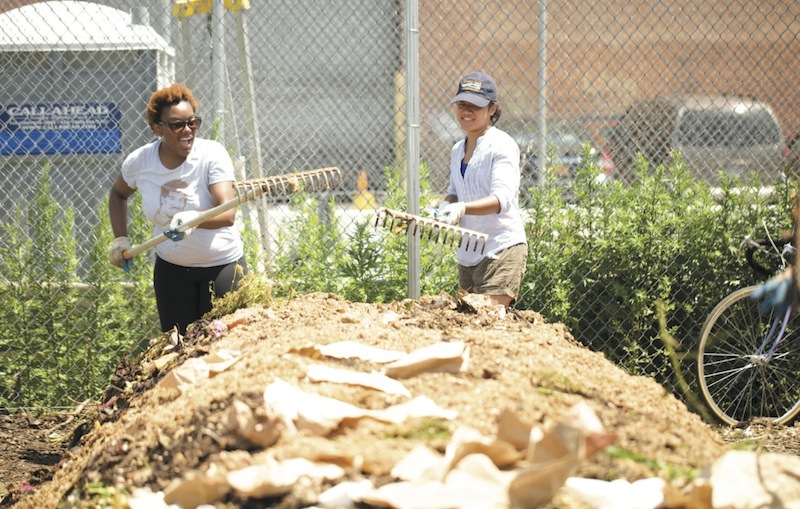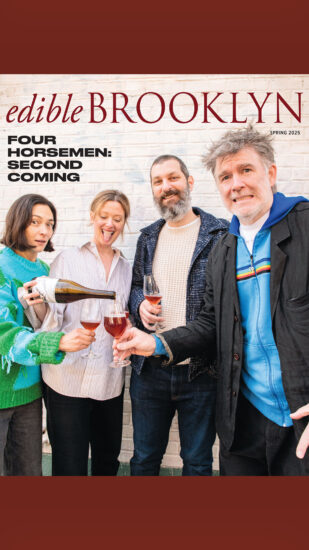If you think you’ve lost your way when headed to one of the Gowanus Canal Conservancy’s volunteer events, don’t worry — you’re probably right on track.
On a recent Sunday afternoon, a chalk sign reading “Compost,” encircled with a pink heart, sat melting in the rain. It marked the entrance to the Salt Lot, a tatty patch of ground just before Second Avenue dead-ends at one of the most polluted bodies of water in the United States. A seeming no-man’s-land, the approach to the conservancy’s volunteer meet-up point is peppered with disused Airlink buses, old tires, scraps of garbage and clinging-to-life weeds.
“Hey, what’s going on down there?” asked a passing hobo as I braced my umbrella against a gust of wind smelling of sewage and wet asphalt. “There’s been so many people passing by!”
Indeed, the weather and unsightly aesthetics were no deterrent for the 30-odd volunteers who turned out that day, all eager to get their hands dirty in a heaping mound of Brooklyn’s organic waste. The scraps, collected from Greenmarkets at Grand Army Plaza, Greenpoint and Borough Hall, will soon be converted into compost, which in turn will nourish beautification and restoration projects the conservancy is spearheading throughout the approximately 1,700-acre Gowanus watershed.
Years before the 1.8-mile-long canal was finally declared an official Superfund site, it tended to conjure thoughts of industrial waste and raw sewage. But a tide of positive change has been improving both the waterway and the neighborhood over the past few years. Eateries such as Four & Twenty Blackbirds and Littleneck draw hungry visitors to the neighborhood, not to mention the new Whole Foods, and artists are increasingly taking up residence right here on the once-shunned block.
“To me, it’s sort of this middle child,” says Natasia Sidarta, a volunteer coordinator. “It’s in this corner of Brooklyn that no one ever goes to, but I think there’s something magical about it.”
Founded in 2009, the nonprofit conservancy dedicates itself to all things Gowanus, including improving the canal’s infamous water quality, promoting local green spaces and building habitat for birds, bats, bees and other creatures eking out a living in or near the waterway’s tainted murk.
Volunteers power these efforts. Anywhere from 20 to 40 people — including corporate volunteers from companies like Whole Foods and Con Edison; school teams; religious groups; or just interested individuals —turn out for events the conservancy organizes. Many come from Gowanus but also from across Brooklyn, even from Manhattan and the Bronx. Monthly composting events tend to draw the biggest crowds, most of whom have never composted before and have little understanding of the process. The conservancy staff gladly brings them up to speed.
“We fully orient volunteers by explaining the larger context of the canal’s ecology, what we’re building and what value it has,” says Christine Petro, a volunteer coordinator. “That knowledge builds morale.”
“Volunteers can also expect to meet a lot of cool people from the neighborhood,” adds Andrea Parker, a conservancy board member and the volunteer committee chair.
Rather than compost using sealed containers and worms imported from Oregon or Pennsylvania, the conservancy lets New York’s own flora and fauna do the decaying. To promote the natural process of turning scraps into soil, volunteers construct windrows: mounds of compost shaped into a pyramid (the flat-topped Aztec variety, not the pointy Egyptian kind). As if making an elaborate compost cake, volunteers alternate shoveling “green” layers— nitrogen-rich market scraps like carrot tops and romaine ends — with “brown” layers — carbon-heavy woodchips, sawdust and leaves supplied by wood-workers, arbors, landscapers and the Brooklyn Botanic Garden. They top off the pyramid with a layer of already-finished compost in order to kick-start the dance of decomposition. In that sense, Sidarta says, “it’s kind of like making yogurt.”
The windrow’s geometry creates a natural convection system, which internally heats up to 160 degrees Fahrenheit as microorganisms get to munching. After two weeks, volunteers or conservancy members turn the windrow, essentially fluffing it up to add the oxygen necessary for good bacterial growth. Over the next several weeks, they begin sifting out fresh soil from the compost, breaking it down into smaller and smaller piles until not a corncob or peach pit remains. Last year, the conservancy processed a staggering 51 tons of food scraps in this way, plus another 50 tons of brown scraps.
Once finished, the conservancy donates the soil to community gardens, sells it to private landscapers or locals or, most often, uses it to nourish its own canal-lined gardens and street tree beds. The constantly replenished compost provides a much-needed nutritional boost for the Salt Lot plants since, in addition to more than a century’s worth of pollution, they must contend with salt-laden soil (in the winter, the Department of Sanitation stores mounds of road de-icing salt at the Salt Lot—hence the name).
“We try to focus on heartier plants and salt marsh plants that can deal with the disgusting conditions they’re put in here,” Parker says. “It’s sort of an urban grit-salt mix.”
On the wildlife side, the conservancy reports that herons, egrets, Canada geese, bats, small fish and crabs have taken up residency around the canal. At the Salt Lot, chartreuse birdhouses welcome nesting feathered friends, and recycled air conditioner ducts from a nearby industrial plant offer perfect homes for chimney swifts. Bees produce honey from two hives kept on the property, although that sweet sustenance needs to be tested for pollution and heavy metals since those potential toxins still heavily contaminate the soil around the canal and can find their way into hungry bees via pollen.
“I’ve eaten the honey; it’s really mild and good,” Sidarta says. “But I wouldn’t feed it to the volunteers.”
Volunteers typically turn up around 11 a.m., and work is completed within three or four hours. Snacks and lunches of hot dogs, chicken and veggie burgers are donated by Whole Foods. Composting is one of the conservancy’s primary efforts, although those who prefer to steer clear of the food scraps may get to work weeding next to the discharge warning sign on the canal’s bank; building floating gardens; constructing bird or bat houses; or mapping the location of trees in order to calculate total water runoff those plants can absorb. These activities go on year round, regardless of rain, snow, sleet or cold.
“Our overall mission is essentially to have a public park around the canal,” Sidarta says. “But that’s a way long-term vision.”
For now, the conservancy and its volunteers are building up the canal, one windrow, birdhouse and floating garden at a time. As the day’s work concludes, the volunteers give the windrow a few final pats with shovels and pitch forks, then gather for a photo around their towering creation.
The rain has stopped now, and Petro pulls out a camera as the volunteers clap and cheer. “This is amazing!” she shouts. “On the count of three-two-one, say ‘Windrow!’”
Find out more: Read about 4 ways NYC makes kitchen composting easy here.
Photo Credit: Clay Williams





